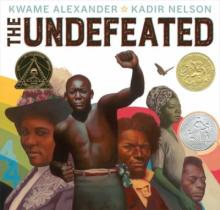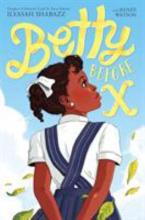The stories on this list acknowledge the hard history of Black struggle in the United States. They also highlight the strength and power of an ongoing push for liberation. In nonfiction, fiction and picture books, these books honor the Black American experience, from individual heroes to mighty collective movements.

"The Newbery Award-winning author of The Crossover pens an ode to black American triumph and tribulation, with art from a two-time Caldecott Honoree"-- Provided by publisher.

"Award-winning author Tonya Bolden explores the black women who have changed the world of STEM (Science, Technology, Engineering, and Mathematics) in America. Including groundbreaking computer scientists, doctors, inventors, physicists, pharmacists, mathematicians, aviators, and many more, this book celebrates over 50 women who have shattered the glass ceiling, defied racial discrimination, and pioneered in their fields. In these profiles, young readers will find role models, inspirations, and maybe even reasons to be the STEM leaders of tomorrow. These stories help young readers to dream big and stay curious. The book includes endnotes, a bibliography, and an index"-- Provided by publisher.

Profiles sixteen high-achieving African Americans, including magician Richard Potter, concert singer Sissieretta Jones, and architect Paul R. Williams.

A fictionalized account of Zora Neale Hurston's childhood with her best friend Carrie, in Eatonville, Florida, as they learn about life, death, and the differences between truth, lies, and pretending. Includes an annotated bibliography of the works of Zora Neale Hurston, a short biography of the author, and information about Eatonville, Florida.

Discovering a book of Langston Hughes' poetry in the library helps Langston cope with the loss of his mother, relocating from Alabama to Chicago as part of the Great Migration, and being bullied.

"For African American women, the fight for the right to vote was only one battle. An eye-opening book that tells the important, overlooked story of black women as a force in the suffrage movement--when fellow suffragists did not accept them as equal partners in the struggle."--Publisher's description.

"A National Book Award Finalist for Non-Fiction, Never Caught is the eye-opening narrative of Ona Judge, George and Martha Washington's runaway slave, who risked everything for freedom. Now in a Young Readers Edition"-- Provided by publisher.

This historical fiction picture book presents the story of nine-year-old Lorraine Jackson, who in 1968 witnessed the Memphis sanitation strike--Dr. Martin Luther King Jr.'s final stand for justice before his assassination--when her father, a sanitation worker, participated in the protest.

Profiles thirty-five prominent men in African American history, including James Armistead Lafayette, Thurgood Marshall, Alvin Ailey, and Leland Melvin.

"When Sharon Langley was born, amusement parks were segregated, and African American families were not allowed in. This picture book tells how a community came together--both black and white--to make a change. In the summer of 1963, because of demonstrations and public protests the Gwynn Oak Amusement Park in Maryland became desegregated and opened to all for the first time. Sharon and her parents were the first African American family to walk into the park, and Sharon was the first African American child to ride the merry-go-round. This was on the same day of Martin Luther King Jr.'s March on Washington for Jobs and Freedom. Sharon's ride to remember demonstrated the possibilities of King's dream ... The carrousel, fully functional, now resides on the National Mall, near the Air and Space Museum."--Provided by publisher.

Relates the story of the National Memorial African Bookstore, founded in Harlem by Louis Michaux in 1939, as seen from the perspective of Louis Michaux Jr., who met famous men like Muhammad Ali and Malcolm X while helping there.

Loretta, Roly, and Aggie B. Little relate their Mississippi family's struggles and triumphs from 1927 to 1968 while struggling as sharecroppers, living under Jim Crow, and fighting for Civil Rights.

In 1870, Reconstruction brings big changes to the Louisiana sugar plantation where spunky ten-year-old Sugar has always lived, including her friendship with Billy, the son of her former master, and the arrival of workmen from China.

Raised by her aunt until she is six, Betty, who will later marry Malcolm X, joins her mother and stepfamily in 1940s Detroit, where she learns about the civil rights movement.

A black family living in Mississippi during the Depression of the 1930s is faced with prejudice and discrimination which its children do not understand.

Describes Tubman's spiritual journey as she hears the voice of God guiding her north to freedom on that very first trip to escape the brutal practice of forced servitude. Tubman would make nineteen subsequent trips back south, never being caught, but none as profound as this first one.

Henry Brown wrote that long before he came to be know as "Box," he "entered the world a slave." He was put to work as a child and passed down from one generation to the next - as property. When he was an adult, his wife and children were sold away from him out of spite. Henry Brown watched as his family left, bound in chains, headed to the deeper South. What more could be taken from him? But then hope - and help - came in the from of the Underground Railroad. Escape! The author, in poems, narrates Henry Brown's story of how he came to ship himself in a box from slavery to freedom.

Presents the history of hip-hop including, how it evolved from folktales, spirituals, and poetry, to the showmanship of James Brown, to the culture of graffiti art and breakdancing that formed around the art form.

In the summer of 1968, after travelling from Brooklyn to Oakland, California, to spend a month with the mother they barely know, eleven-year-old Delphine and her two younger sisters arrive to a cold welcome as they discover that their mother, a dedicated poet and printer, is resentful of the intrusion of their visit and wants them to attend a nearby Black Panther summer camp.

A luminous picture book biography about librarian and storyteller Augusta Baker, the first Black coordinator of children's services at all branches of the New York Public library.